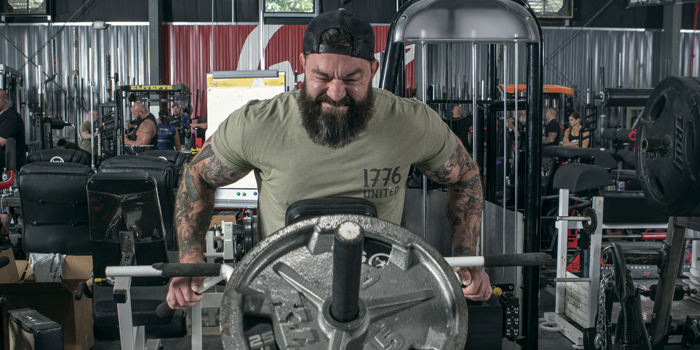
So you're thinking about working out twice a day, huh? Or maybe that thought had never crossed your mind until you read the title of this article. Training twice a day can offer several significant benefits but presents some downfalls based on program structure and execution.
The first experience many, myself included, may have with training twice a day is high school sports. In my freshman year of high school football, we had "double sessions" in the summer during our pre-season training. It was a method of getting in as much training as possible in the short time we had available before the season started. It also served as a means of mental fortitude for a 14-year-old training twice a day with 18-year-old men with beards and chest hair.
The purpose of this article, though, is not to address any sport-specific training but specifically how to program your powerlifting or bodybuilding training around a twice-daily routine. I'll touch on the positives and negatives of training twice a day, some examples and recommendations of how to apply twice-daily training in your programming, and some specific issues to try and avoid if you want to get the best out of your training.
Positives of Twice-Daily Training
There are several benefits to training twice a day, but the overarching theme should revolve around increasing the quality of training. When you are fresh and motivated at the beginning of your training session, you should produce high-quality rep after high-quality rep. Midway through, you hit a rep PR or two, but then you reach a point where the muscles become too fatigued to increase performance. At this point, you may be accumulating "junk volume."
MORE: How to Achieve Your Training Goals
Junk volume includes sets of training that are burning calories, contributing to fatigue, but not stimulating muscle, strength, or neurological technique gains. You're simply "working out" and not training anymore. What makes this worse is you are adding fatigue which will deplete recovery resources.
By dividing that training session, you can stop the training session before you hit the point of intra-session fatigue, thus eliminating the potential for junk volume. You can stop once you've completed all the high-quality work you can do in one session, rest, eat, recover, and then perform the rest of the workout hours later in a session dedicated specifically to what would have been the end of your workout.
You will now be able to approach those muscle groups or lifts with the same energy and focus you hit the earlier muscle groups with.
There's a reason the saying goes, "he's in mid-season form," and not "he's in late-season form." In the middle of a season, an athlete is still motivated and excited about the season. They have the preparation of the beginning of the season behind them, so they are focused and productive. They also have not incurred much of the wear-and-tear that a full season imposes, so they're firing on all cylinders and performing at their highest level. This analogy can be applied to every workout. By splitting up your training volume into two sessions, you can set yourself up to be in "mid-season form" for every set that day.
Timing is another benefit of training twice a day. It allows you to break up what would be a one- to two-hour session into two sessions, each half that time.
Depending on your work/family schedule, you may not have hour blocks of time available consistently, but 30- to 45-minute blocks of time may be open multiple times during the day.
Negatives of Twice Daily Training
If you train for any strength or physique sport, chances are you enjoy training and being in the gym. Therefore, the thought of being in the gym twice might sound great, but there are a few negatives to twice-daily training.
For one, being in the gym requires preparation. For those who work at a gym or have a home gym, this may not contribute much or any inconvenience or extra work. But for others, driving to/from the gym twice, creating extra dirty laundry, and showering before you put on your business clothes and head back to the office can add additional stress to the day.
One way I deal with this is to create a training program that fits into the logistics of my day; therefore, I recommend having multiple training locations. Take for example, training in the PM at the town rec center on the way home from work; or training in the AM at your modest home gym, then hitting your PM session at the nearby, fully-equipped gym with a training partner.
Since the workouts are only a fraction of the full day's volume, you aren't spending all day at the gym, just breaking it up into two sessions at two different locations.
Another potential negative is the nutritional organization that goes into optimizing the two-a-day workout schedule. Getting proper nutrition is crucial to ensure each session is effective and has you on track to reach your goals.
You will now have two pre- and post-workout meals. The more time you have between session one and session two, the less of a factor this becomes, as there are more opportunities for feedings between workouts. While we know the "anabolic window" is not nearly as important as the mid-2000s bodybuilding magazines made us think it was, the "inter-workout window" is important.
As your first training session will use up a large portion of the carbohydrates available to the muscle, getting in another relatively high carbohydrate meal should occur between sessions. Two meals would be great, but depending on timing, you don't want that second pre-workout meal to be too close or too dense that it impedes your ability to perform in session two.
A post-workout shake made of whey protein and a fast-digesting carbohydrate powder right after session one, followed up by a whole food meal of lean protein and easily-digestible carbs at least an hour out from session 2 would probably be my best recommendation to optimize the "inter-workout window" without overcomplicating things.
Practical Applications for Twice-Daily Training
As mentioned previously, the purpose of twice-daily training is not to provide you with a means to add more training volume but to make your training volume more effective. Regardless of how many days a week, twice-daily training can be considered a viable option to improve training quality.
If training less than four days a week, I'd suggest adding another session on another day before trying to add another session on the same day.
Twice-daily training can be implemented effectively for both hypertrophy and strength programming. How muscle groups and lifts would be split largely depends on the frequency with which they are programmed to be trained.
Several examples of splits are provided below:
Hypertrophy Layouts
*Note: All AM/PM sessions could easily be flipped to best suit your needs/schedule.
4 Days/Week
| AM Session | PM Session | |
| Day 1 | Chest/Back | Delts/Biceps/Triceps |
| Day 2 | None | Hamstrings/Calves/Quads |
| Day 3 | Chest/Back | Delts/Biceps/Triceps |
| Day 4 | None | Hamstrings/Calves/Quads |
5 Days/Week
| AM Session | PM Session | |
| Day 1 | Chest/Back | Delts/Biceps/Triceps |
| Day 2 | None | Hamstrings/Calves/Quads |
| Day 3 | Chest/Back | Delts/Biceps/Triceps |
| Day 4 | None | Hamstrings/Calves/Quads |
| Day 5 | Chest/Back | Delts/Biceps/Triceps |
6 Days/Week
| AM Session | PM Session | |
| Day 1 | None | Hamstrings/Calves/Quads |
| Day 2 | Chest | Rear Delts/Biceps/Forearms |
| Day 3 | Back | Front Delts/Side Delts/Triceps |
| Day 4 | None | Hamstrings/Calves/Quads |
| Day 5 | Chest | Rear Delts/Biceps/Forearms |
| Day 6 | Back | Front Delts/Side Delts/Triceps |
*Notes: Leg training could be split up into an AM/PM session, but hamstrings typically do not require as much volume as the quads. Also, doing hamstring work immediately before quads acts as a nice warm-up for the quad work.
Strength Layouts
If the AM session is at a powerlifting-equipped gym, hit the main lifts and the corresponding accessory lifts in the PM, as laid out in the following 4- and 5-day layouts.
4 Days/Week
| AM Session | PM Session | |
| Day 1 | Deadlift | Lower Accessories (Light squat variations, lower back, abs) |
| Day 2 | Bench | Upper Accessories (Back/Delts/Triceps) |
| Day 3 | Squat | Lower Accessories (light deadlift variations, lower back, abs) |
| Day 4 | Overhead Press | Upper Accessories (Chest/Back/Triceps) |
5 Days/Week
| AM Session | PM Session | |
| Day 1 | Deadlift | Lower Accessories (Light squat variations, lower back, abs) |
| Day 2 | Bench | Upper Accessories (Delts/Triceps) |
| Day 3 | Back Hypertrophy | None |
| Day 4 | Squat | Lower Accessories (light deadlift variations, lower back, abs) |
| Day 5 | Overhead Press | Upper Accessories (Chest//Triceps) |
If the PM session is at a powerlifting-equipped gym, hit the main lifts and the corresponding accessory lifts in the AM on a different day, as laid out in the following 4- and 5-day layouts. The purpose of this is to prevent the AM accessory workouts from negatively impacting the PM main lift session. Blasting your triceps in the morning is not smart if you plan on benching heavy later that day.
4 Days/Week
| AM Session | PM Session | |
| Day 1 | Upper Accessories (Back/Delts/Triceps) | Deadlift |
| Day 2 | Lower Accessories (Light squat variations, lower back, abs) | Bench |
| Day 3 | Upper Accessories (Chest/Back/Triceps) | Squat |
| Day 4 | Lower Accessories (light deadlift variations, lower back, abs) | Overhead Press |
5 Days/Week
| AM Session | PM Session | |
| Day 1 | Upper Accessories (Delts/Triceps) | Deadlift |
| Day 2 | Lower Accessories (Light squat variations, lower back, abs) | Bench |
| Day 3 | Back Hypertrophy | None |
| Day 4 | Upper Accessories (Chest//Triceps) | Squat |
| Day 5 | Lower Accessories (light deadlift variations, lower back, abs) | Overhead press |
First Responders and those in medical careers may only be able to train two or three times a week. Because there is so much time off from training during the week, per session training volume can be higher than a 5- or 6-day split.
2 Day/Week
Hypertrophy
| AM Session | PM Session | |
| Day 1 | Hamstrings/Calves/Quads | Chest/Back/Delts/Arms |
| Day 2 | Chest/Back/Delts/Arms | Hamstrings/Calves/Quads |
Strength
| AM Session | PM Session | |
| Day 1 | Deadlift/Bench | Full Body Hypertrophy |
| Day 2 | Squat/Overhead Press | Full Body Hypertrophy |
3 Day/Week
Hypertrophy
| AM Session | PM Session | |
| Day 1 | Delts/Arms | Hamstrings/Calves/Quads |
| Day 2 | Back/Rear Delts/Biceps | Chest/Front & SideDelts/Triceps |
| Day 3 | Hamstrings/Calves/Quads | Chest/Back |
Strength
| AM Session | PM Session | |
| Day 1 | Deadlift | Upper Accessories |
| Day 2 | Bench/Overhead Press | Lower Accessories |
| Day 3 | Squat | Upper Accessories |
Closure
Twice-daily training may be what you need to get in the training volume to better progress, reach your goals, and be more successful. If used correctly, it can improve the quality of your training and, more importantly, your life!

James Brennan has spent a decade as a biology and nutrition teacher at a public high school in New Jersey. He also served as the school’s strength and conditioning coach working with student-athletes in individual and team settings. He competes in powerlifting in the 198, 220, and 242 weight classes. Overall, his most important and enjoyable roles are husband and father.









